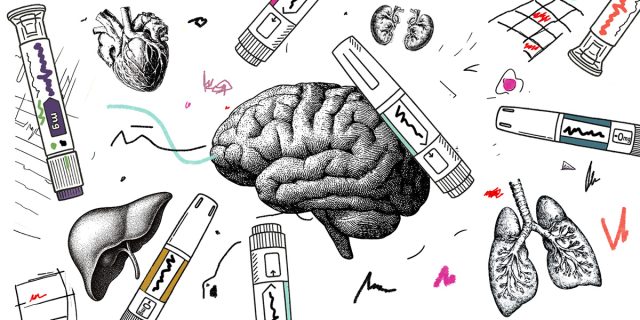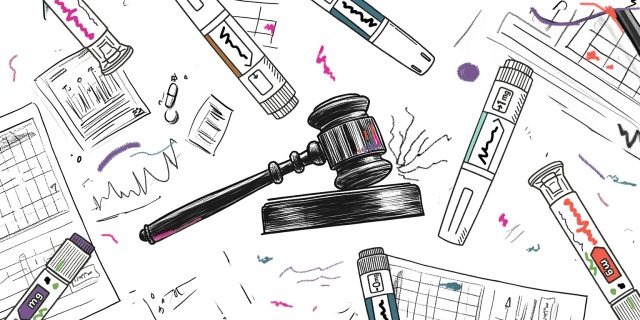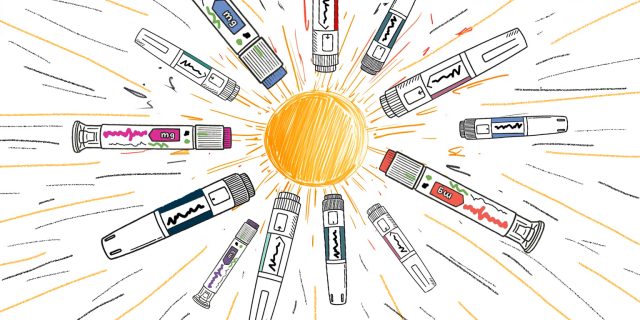Beyond the Scale: The Ozempic Effect
First identified in the 1970s, GLP-1 medications have shaped diabetes treatments. Recent use of these drugs for weight loss has raised questions about insurance, cost and safety. Research and expert interviews reveal how demand for GLP-1 drugs is impacting health care across the country.
Our content is developed and backed by respected legal, medical and scientific experts. More than 30 contributors, including product liability attorneys and board-certified physicians, have reviewed our website to ensure it’s medically sound and legally accurate.
legal help when you need it most.
Drugwatch has provided people injured by harmful drugs and devices with reliable answers and experienced legal help since 2009. Brought to you by Wilson & Peterson LLP, we've pursued justice for more than 20,000 families and secured $324 million in settlements and verdicts against negligent manufacturers.
More than 30 contributors, including mass tort attorneys and board-certified doctors, have reviewed our website and added their unique perspectives to ensure you get the most updated and highest quality information.
Drugwatch.com is AACI-certified as a trusted medical content website and is produced by lawyers, a patient advocate and award-winning journalists whose affiliations include the American Bar Association and the American Medical Writers Association.
About Drugwatch.com
- 15+ Years of Advocacy
- $324 Million Recovered for Clients
- 20,000 Families Helped
- A+ BBB Rating
- 4.9 Stars from Google Reviews
Testimonials
I found Drugwatch to be very helpful with finding the right lawyers. We had the opportunity to share our story as well, so that more people can be aware of NEC. We are forever grateful for them.
- Last update: August 18, 2025
- Est. Read Time: 16 min read
Ozempic and other GLP-1 drugs have changed the treatment landscape for diabetes and obesity. Celebrated for their weight loss and health benefits, these medications also raise concerns about access, cost, safety and ethics.
Using insights from our podcast series, Beyond the Scale: The Ozempic Effect, Drugwatch examines the complexities of insurance coverage, the role of health care providers and the risks of off-label use.
Through expert opinions and patient experiences, we consider the need for responsible prescribing, improved education and equitable access for those who could benefit from Ozempic, Wegovy and other GLP-1 therapies.

The Rise of Ozempic and Other GLP-1 Drugs
Ozempic, Wegovy, Zepbound and other GLP-1 medications have recently become a social phenomenon shaping diabetes and weight loss treatment, but the history of the drug class goes back at least as far as 1971.
“For the longest time, the drugs that we used to treat Type 2 diabetes have always been weight-promoting,” Dr. William Hsu, an endocrinologist and former Harvard Joslin Diabetes Center faculty member, told Drugwatch.
People who take insulin may gain weight as insulin allows sugar to enter the cells to bring blood sugar down. If you eat more calories than needed, your cells will get too much sugar. When your cells don’t use that sugar, it turns into fat and can cause weight gain.

Did You Know?
A hormone in the venom of the Gila monster, a lizard from the southwestern United States, inspired the first GLP-1 diabetes medication. This hormone, exendin-4, is similar to GLP-1 in the human body. Both stimulate insulin production in humans to help regulate blood sugar. It also degrades more slowly in the human body than GLP-1, so it’s more effective than other medications in treating diabetes.
According to Dr. Hsu, introducing GLP-1 receptor agonists marked a turning point for diabetes treatment and also weight management.
“The GLP-1 class is one of the first class[es] of medication that was introduced into medicine that both lowers glucose, but at the same time drives weight loss. That was kind of the value proposition for many of the clinicians or the patients,” Dr. Hsu said.
-
1971
Jens Juul Holst from the University of Copenhagen identifies "enteroglucagon" (later named GLP-1) as a molecule that enters the bloodstream from the gut and regulates blood sugar.
-
1980s
Holst, along with Joel Habener from Harvard and Daniel Drucker from the University of Toronto, discover that GLP-1 works by improving insulin release, suppressing glucagon and slowing stomach emptying.
-
2005
Byetta (exenatide) becomes the first FDA-approved GLP-1 agonist for Type 2 diabetes. The active ingredient was synthesized from Gila monster venom.
-
2010
Novo Nordisk’s Victoza (liraglutide) gains FDA approval for Type 2 diabetes. It received approval to treat obesity in 2014.
-
2014
The FDA approves Saxenda (liraglutide) to treat obesity.
-
2017
Ozempic (semaglutide) is approved for Type 2 diabetes.
-
2021
Wegovy (semaglutide) receives FDA approval for chronic weight management in people with a weight-related condition like high blood pressure, high cholesterol or Type 2 diabetes.
-
2022
Lilly’s Mounjaro (tirzepatide) is approved for Type 2 diabetes treatment.
-
2023
Lilly’s Mounjaro (tirzepatide) is approved for Type 2 diabetes treatment.
-
2023
A study published in the New England Journal of Medicine found that semaglutide reduces heart attacks and strokes by 20% in high-risk patients.
Wegovy and Ozempic are prescribed under different brand names and in varying doses. However, semaglutide, the active ingredient in both, can treat diabetes and obesity.
Weight loss was an unexpected side effect noted in early clinical trials, according to Dr. Lauren Cunningham, a clinical pharmacist at the clinical faculty at the University of Illinois Chicago (UIC) Retzky College of Pharmacy and clinical pharmacist at the University of Illinois Hospital and Health Sciences System.
“When these medications were being studied, particularly liraglutide or Victoza, researchers saw that people were losing weight in these studies,” Dr. Cunningham told Drugwatch. “So they went ahead and did some more focused research on weight loss with those agents.”
“The GLP-1 class is one of the first class[es] of medication that was introduced into medicine that both lowers glucose, but at the same time drives weight loss."
Cunningham said that the weight loss discovery was a turning point when Saxenda, a higher dose version of liraglutide found in Victoza, was approved in 2014 for chronic weight management with or without a diagnosis of Type 2 diabetes.
As Ozempic’s reputation for weight loss spread, demand exploded beyond its original purpose. Dr. Ashley Dwyer, a former retail pharmacist turned health coach, observed the shift firsthand.
“Now in the weight loss industry, it’s just huge … There’s definitely a subset of people who definitely need this medication,” Dr. Dwyer told Drugwatch. “They’re amazing, I love them, but the way that it is portrayed for vanity weight loss or just kind of like available at the touch of a button on a computer really concerns me.”
Dwyer also worries that people seeking the drugs for weight loss may not understand exactly how they work.
“There are people who think it is a quick fix. They just get on this for a couple of months, it drops their weight and then they go about their life the way they were before,” Dr. Dwyer said. “It’s kind of like any fad diet … and because of the side effect profile, I’m just not obviously a fan of that.”

How GLP-1 Drugs Work
GLP-1 drugs help with weight loss and blood sugar control by slowing digestion. You can combine these medications with lasting healthy lifestyle changes for the best results.
“It has multiple impacts on the body. It primarily slows down gastric emptying. That means the emptying of food from the stomach pouch,” Dr. Hsu said. “Food literally sits in the stomach for a longer period of time and causes that sensation of satiety. People feel fuller when they’re on these medications.”
This delayed gastric emptying is one reason many patients experience reduced appetite and, in some cases, side effects. As the medication slows down the emptying of food from the stomach, it can also cause nausea and vomiting, Dr. Hsu pointed out.
GLP-1 medications help control blood sugar levels in what Hsu calls “a rather smart way.” When blood sugar levels are high, these medications trigger the pancreas to release insulin to help lower the sugar. However, when blood sugar levels are normal or low, they don’t cause the pancreas to release more insulin.
This is just one of the ways GLP-1s work. Hsu also points out that these medications prevent the liver from releasing extra sugar into the bloodstream when sugar levels are too high.
“Food literally sits in the stomach for a longer period of time and causes that sensation of satiety.”
Despite their weight loss effectiveness, some experts who spoke to Drugwatch cautioned that GLP-1 drugs are not a “quick fix.” Diet and exercise are still essential for keeping weight off.
“We try and encourage diet, lifestyle, exercise and just behavior change along with mindset change, because a lot of this is also a poor relationship with food, using food as a coping mechanism,” Dr. Dwyer said.

High Cost and Barriers to Access
Costs can limit access to GLP-1 drugs for weight loss. These medications have high out-of-pocket costs, with list prices ranging from $1,000 to $1,500 monthly in the United States.
Insurance coverage remains fragmented. Most plans cover these medications for diabetes, but often exclude weight loss, leaving non-diabetic patients to pay the full cost.
“They’re so expensive because there’s a lot of consumer demand for the drugs and … they’re very promising in the outcomes they produced,” Robert Andrews, CEO of the Health Transformation Alliance (HTA), told Drugwatch. “Why are they so expensive? Because the pharma companies can charge what they can charge.”
“Why are [GLP-1 medications] so expensive? Because the pharma companies can charge what they can charge.”
The high cost of GLP-1 drugs has been challenging for employer health care plans. They are expensive for insurers, and many plans will only cover the medictions for diabetes care. But there’s high demand among employees who want GLP-1 drugs for weight loss.
Employers are caught in the middle. Large corporations have often paid for weight loss coverage, but small businesses may be unable to afford it.
Pharmacy Benefit Managers Add to GLP-1 Costs
Pharmacy benefit managers (PBMs) serve as middlemen to help health insurers manage drug costs. They decide which medicines are covered, determine prices and negotiate discounts between drug companies, insurers and pharmacies.
According to Dr. Steve Boyd, a PBM reform advocate, traditional PBMs can exacerbate GLP-1 costs.
“There’s no doubt that traditional PBMs often are profiteering from the actual ingredient,” Dr. Boyd told Drugwatch. “In the case of GLP-1s, drugs that cost in the neighborhood of around $1,100, there’s an opportunity that a PBM could mark that claim up by attaching spread or a variety of different fees.”
Equity: Diabetes Patients vs. Weight Loss Users
There’s a growing debate about whether health insurance should cover GLP-1 drugs for weight loss.
Most insurance plans don’t cover these drugs for weight management. This leaves many patients without access to treatment that could improve their health and quality of life.
“Many employers for whom retention and recruitment of employees is a major priority are trending toward covering the drug not just for diabetes, but also for sustained weight loss.”
Andrews points out that many insurance companies are drawing a line at whether GLP-1s are medically necessary or cosmetically desirable. However, employers increasingly want coverage included in their plans.
“Many employers for whom retention and recruitment of employees is a major priority are trending toward covering the drug not just for diabetes, but also for sustained weight loss,” Andrews said.

Risks of Off-Label Use and Compounded GLP-1 Drugs
Off-label use, using a drug to treat a condition it’s not approved for, can result in adverse reactions. Similarly, compounded GLP-1 drugs can raise questions and concerns over medication quality. However, these risks don’t seem to deter some people.
Compounded GLP-1 drugs are versions of medications made on-site by independent pharmacies known as compounding pharmacies. Unlike FDA-approved drugs made by brand-name manufacturers, there is typically less oversight of compounding pharmacies.
By 2023, nearly half of GLP-1 prescriptions were for non-diabetic uses. According to IQVIA, a data, technology and research company, obesity treatments accounted for 27% of off-label Ozempic prescriptions.
Telehealth platforms drove almost 50% of this growth, enabling quick access for cosmetic weight loss.
Online ordering and direct-to-consumer platforms offering GLP-1s for weight loss worry Dr. Elizabeth Van Dril, a clinical pharmacist at the University of Illinois Chicago’s Retzky College of Pharmacy.
“That can be risky if people are getting prescribed unapproved formulations in the form of compounded medications or if they’re not receiving the appropriate education on how to use those medications safely and effectively,” Dr. Van Dril told Drugwatch.
Critics also argue that pharmaceutical marketing blurs the lines between necessity and vanity. Despite FDA bans on off-label claims, direct-to-consumer ads spent $809M in 2023 promoting Ozempic, Wegovy, Mounjaro and Rybelsus.
Compounded Drugs May Present Further Risks
The FDA has issued a warning about using weight loss medications, specifically GLP-1 drugs like semaglutide and tirzepatide, that haven’t been approved or are compounded differently. These unapproved, compounded versions haven’t been checked for effectiveness, safety or quality.
“The compounding pharmacists have created versions of the GLP-1s, which raises a lot of clinical issues about clinical propriety,” Andrews said.
He recounted a radio commercial he recently heard touting a drug that “had the same elements, active ingredients as GLP-1s, but costs a fraction” of what the FDA-approved versions cost.
“The question popped into my mind: Is this clinically safe or not?” he said.
Andrews, a former congressman from New Jersey, helped author the Affordable Care Act while serving in the U.S. House of Representatives. He is familiar with health care regulations and FDA approvals.
“I’m virtually a hundred percent confident in the FDA’s clinical review of drugs that [the agency] reviews,” he said. “Not so confident in compounding pharmacists because the FDA plays a smaller role there.”
Some people taking compounded GLP-1 medications have experienced health issues due to dosage mistakes, either taking too much or using it too frequently. The FDA is also concerned about different and potentially less effective versions of these drugs.
As of Feb. 28, 2025, the FDA had received 775 reports of adverse events linked to compounded versions of GLP-1 drugs, including:
- Abdominal pain
- Constipation
- Diarrhea
- Nausea
- Vomiting
The FDA recommends getting a prescription from your doctor and filling it at a licensed pharmacy. Always ask your doctor if you have questions about your medicines.
For safe online purchases of medications, visit the FDA’s BeSafeRx campaign.

Ozempic and Other GLP-1 Medication Side Effects Uncovered
Though widely used, GLP-1 drugs come with a spectrum of side effects. These can include gastrointestinal issues and rare but severe risks like stomach paralysis or vision loss.
Common Side Effects
Gastrointestinal issues are common side effects of GLP-1 medications. Nausea is the most frequently reported problem, impacting up to 50% of patients.
The most common GLP-1 side effects include:
- Loss of appetite
- Constipation
- Diarrhea
- Nausea
“It mainly happens because these medications are slowing down how quickly that food moves from your stomach into the rest of your digestive system,” Dr. Cunningham told Drugwatch. “For most people, this effect usually lessens over time as your body gets used to the medicine.”
She explained that doctors typically start you on a low dose of GLP-1 and increase it slowly, monitoring any symptoms and how well you tolerate the medication.
Serious and Rare Risks
While most side effects are mild, some can be serious. Ozempic and Wegovy have a boxed warning for possible thyroid cancer risk based on animal studies. They have also been linked to pancreatitis, gallbladder disease and acute kidney injury.
“It’s important to understand that safe doesn’t necessarily mean that the drug is free of side effects,” Dr. Van Dril told Drugwatch. “Rather, it means that the FDA has concluded that the benefits of the drug outweigh its potential risk for that specific condition that it’s meant to treat.”
Many of the severe side effects include gastrointestinal conditions:
- Gastroparesis (stomach paralysis): This condition happens when the muscles in your stomach don’t work properly to move food along for digestion. It can cause issues ranging from nausea and vomiting to malnutrition and blood sugar changes.
- Ileus: This is a condition where your bowel isn’t functioning correctly, but there isn’t any physical issue causing an obstruction. Ileus can cause problems like abdominal swelling, constipation and vomiting.
- Intestinal obstruction: An intestinal obstruction is when something partially or completely blocks your intestines. This means that food and waste can’t move through your intestines properly. Obstructions can cause abdominal pain, breath odor and nausea.
In addition, multiple 2024–2025 studies found that semaglutide users may have a higher risk of developing a specific eye condition called nonarteritic anterior ischemic optic neuropathy (NAION).
NAOIN is when blood stops flowing to the optic nerve, which connects your eye to your brain. It usually leads to sudden and painless vision loss in one eye. The condition is sometimes linked to obesity or diabetes, which are issues patients may treat with GLP-1s.
A 2025 study in Investigative Ophthalmology & Visual Science found that GLP-1 users are more than three times more likely to develop NAION than non-users.

Lawsuits Claim Vision Loss and Stomach Paralysis
Some people who have taken Ozempic or other GLP-1 medications and suffered NAION or stomach paralysis have filed lawsuits against the drug’s manufacturers.
GLP-1 Lawsuits Targeting Gastrointestinal Injuries
Lawsuits alleging gastrointestinal injuries have targeted multiple GLP-1 drugs and their manufacturers.
Jaclyn Bjorklund was among the first to file an Ozempic and Mounjaro lawsuit in 2023. She sued manufacturers Novo Nordisk and Eli Lilly, claiming the medications caused severe gastrointestinal injuries.
After taking Ozempic and Mounjaro, Bjorklund started having severe stomach problems. Her lawsuit claims she experienced ongoing vomiting, stomach aches and a burning sensation in her belly.
Bjorklund’s symptoms became so bad that she had to go to the emergency room several times and eventually required hospitalization for stomach problems. Doctors had to give her extra medicine to help control her vomiting.
Her vomiting was so extreme that Bjorklund lost teeth and sometimes threw up food hours after eating. These issues have caused pain and distress.
Bjorklund’s Ozempic lawsuit was filed in a Louisiana federal court. It was one of 18 GLP-1 lawsuits claiming patients “suffered gastroparesis, ileus, intestinal obstruction or pseudo-obstruction, or other gastrointestinal injury.”
These cases were consolidated into a multidistrict litigation (MDL). MDLs allow several similar lawsuits to be combined in one court to simplify the legal process.
A federal panel set up MDL-3094 in an eastern Pennsylvania federal court in February 2024. As of December 2025 there were 2,947 lawsuits pending in the litigation.
GLP-1 Lawsuits Targeting Vision Injuries
Ozempic lawsuits claiming NAION and vision loss injuries have emerged following the 2024 and 2025 studies linking the drugs to a higher risk of developing NAION.
Danielle Gold, an attorney at Weitz & Luxenberg, said that Novo Nordisk, the manufacturer of Ozempic and Wegovy, hasn’t done a good job of informing patients about the risks. Gold is part of the firm’s drug and medical device unit at the forefront of GLP-1 lawsuits.
“NAION … is a very serious and life-altering injury that can be caused by use of Ozempic or Wegovy,” Gold told Drugwatch. “Novo Nordisk continues to promote and sell these products without any warning or discussion in their label regarding a risk of permanent vision loss.”
According to Gold, lawsuits allege that Novo Nordisk failed to warn patients and doctors about the risk of permanent blindness, even as new research found a significantly increased risk of NAION among semaglutide users.
"NAION … is a very serious and life-altering injury that can be caused by use of Ozempic or Wegovy."
“If you develop NAION while on this medication, it will likely result in permanent visual impairment,” Gold said.
Gold and her firm seek to coordinate these cases in the New Jersey State Court. They aim to hold the manufacturers accountable for what they describe as life-changing injuries.
European Union Requires NAION Warnings for Semaglutide
In June 2025, the European Medicines Agency (EMA) required semaglutide products — Ozempic, Wegovy and Rybelsus — to include a warning that the medications may cause a “very rare” increased risk of NAION. The EMA is the European Union counterpart to the FDA in the United States and only applies to semaglutide sold in the EU.
The EMA safety committee found that semaglutide NAION can lead to sudden vision loss and may affect up to 1 in 10,000 people taking semaglutide.
After reviewing studies and patient data, researchers found that people with Type 2 diabetes taking semaglutide may have about twice the risk of developing NAION compared to those not taking the drug. This means that for every 10,000 people using semaglutide for one year, there may be one extra case of this eye condition.
The EMA recommends that if you take Ozempic, Wegovy or Rybelsus and suddenly lose vision or notice your eyesight quickly worsening, you should contact your doctor immediately. If NAION is diagnosed, you may need to stop taking the medicine.
You should stay alert to sudden vision problems and act quickly to protect your sight. Always talk to your doctor before making any changes to your treatment.

The Future of Ozempic, Wegovy and other GLP-1 Medications
Drugwatch asked the experts we interviewed what they saw as the future of Ozempic, Wegovy and other GLP-1 medications. Their answers ranged from seeing the drugs as a game-changer the to questioning the risks of unsupervised use. They brought up a need to change our health care system and a future where new therapies may allow greater control over diabetes.
Calling this number connects you with a Drugwatch.com representative. We will direct you to one of our trusted legal partners for a free case review.
Drugwatch.com's trusted legal partners support the organization's mission to keep people safe from dangerous drugs and medical devices. For more information, visit our partners page.



